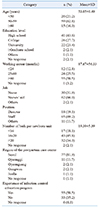Abstract
Background
This study was conducted to investigate the educational needs of employees in charge of practical services at postpartum care centers and to test the improvement of infection control-related knowledge after developing and implementing educational programs that reflect their needs.
Methods
On the basis of research of the literature on educational requirements and consultations with researchers and experts, we developed educational programs on infection control. A total of 136 postpartum care workers participated in the program. To assess the effectiveness of the program, the degree-of-knowledge and satisfaction of the program were measured before and after the education. The educational program consisted of four themes over 200 minutes (50 minutes each).
Results
After training, the participants' overall infection control knowledge increased from 84.36 points to 89.04 points. The participants were satisfied with the program; they were satisfied with their knowledge acquisition (4.59±0.66 points), with the practical application of the content (4.59±0.65 points), and with the education program itself (4.52±0.67 points).
Conclusion
As the positive effects of the educational program have been identified, the program can be extended to all postpartum care workers. Continuous development and implementation of educational programs are necessary to strengthen the capability of postpartum care workers, allowing them to effectively manage infection in the future.
Figures and Tables
References
1. Yoo EK. Women's postpartal cultural need: rethinking on the meaning of Sanhujori, the traditional postpartal care in Korea and its clinical application. Korean Nurs. 1998; 37:27–40.
2. Ministry of Health and Welfare. Status of postpartum care centers in Korea. Updated on 5 Jun 2019. http://www.mohw.go.kr/react/jb/sjb030301vw.jsp?PAR_MENU_ID=03&MENU_ID=0321&CONT_SEQ=345843&page=1.
3. Park JY, Kim DH, Bae SY, Choi CH, Cho EY, Choi JH, et al. Study of nosocomial rotavirus infection in neonates admitted to a postpartum-care center. Korean J Pediatr Infect Dis. 2007; 14:145–154.

4. Ministry of Government Legislation. Maternal and child health act. Updated on 23 Apr 2019. http://www.law.go.kr/%EB%B2%95%EB%A0%B9/%EB%AA%A8%EC%9E%90%EB%B3%B4%EA%B1%B4%EB%B2%95.
5. Jeong IS, Lee SJ, Jeong JS, Yoon SW, Jeong SY, Ha J, et al. Development of infection control guideline for postpartum care centers. Korean J Nosocomial Infect Control. 2013; 18:57–88.

6. Lee JT. Continued increase of infection damage in postpartum care centers. Medical Newspaper;Updated on 17 Oct 2018. http://m.bosa.co.kr/news/articleView.html?idxno=2092100.
7. Kim JS, Choi JH, Shin YJ, Goo ML, Kim SS, Kim YH, et al. A study on the critical neonate with severe deterioration after transfer from postpartum care. J Korean Soc Matern Child Health. 2002; 6-21.
8. Planned Population Federation of Korea. Postpartum care education program guide for the first quarter of 2018. Updated on 29 Jan 2018. http://www.ppfk.or.kr/sub/notice/event.asp?mode=view&bid=1&s_type=&s_keyword=&s_cate=&idx=4438&page=6.
9. Richey RC. Defining a field: a case study of the development of the 1994 definition of instructional technology. Edu Media Technology Yearbook. 1994; 20:2–17.
10. Hong SJ, Kim DK, Lee DS, Cho SM, Choi SM. RSV outbreak at a single postpartum care center in Gyeongsangbukdo. Korean J Perinatol. 2016; 27:60–66.

11. Yang KM, Park SH, Kim IS, Lee JH, Lee HY, Kwon TJ, et al. Report of newborn deaths at post-delivery care facilities in 2001 and 2002. Korean J Leg Med. 2002; 26:33–46.
12. Kwon DB. Adult education method. Seoul: Hakjisa;1999.
13. Shin EK. Analyses about trends of measurement and reliability generalization of tools for learning transfer: centered on articles published on Korean journals between 1996–2013. Korean J Hum Resour Dev. 2014; 16:51–86.
14. Kim SJ, Ji HR, Kim NY, Lim YJ. Study on the current state and demand on the nursing continuing education in Gwangju. J Learn Cent Curric Instr. 2017; 17:575–596.

15. Yoon JH. Analysis of new nurses' need for intravenous infusion therapy education [Master thesis]. Jinju: Gyeongsang National University;2019.
16. Lee HJ, Go Y, Kim SY, Kim CM, Kim HK, Park KH, et al. Health education methodology. Paju: Soomoonsa;2018.




 PDF
PDF ePub
ePub Citation
Citation Print
Print









 XML Download
XML Download